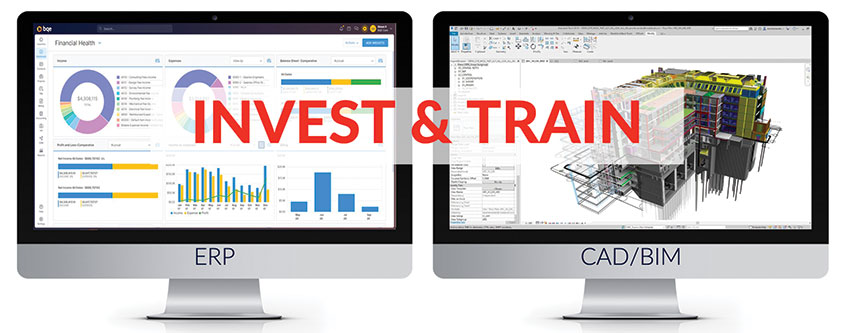11 Top Key Performance Indicators (KPIs) of Successful Firms
Learning Objectives:
- Describe why managing your project and firm health is as crucial as managing your own health.
- List the 11 Key Performance Indicators (KPIs) that every firm must understand and what they really mean for your firm’s health.
- Define and quantify KPIs that are meaningful to achieve your business and personal goals.
- Recognize how technology plays into managing a healthy firm, just as it does with managing your own health.
Credits:
This course is approved as a Structured Course
This course can be self-reported to the AANB, as per their CE Guidelines
Approved for structured learning
Approved for Core Learning
This course can be self-reported to the NLAA
Course may qualify for Learning Hours with NWTAA
Course eligible for OAA Learning Hours
This course is approved as a core course
This course can be self-reported for Learning Units to the Architectural Institute of British Columbia
Architects, engineers, and other design professionals often find themselves in the position of needing to successfully (i.e., profitably) manage projects, or a portion of a firm, or even the entire firm. Others see the potential in starting their own firm but struggle with the uncertainties of how to do it and make money at it. In many of these situations, the most common mantra heard is “we never learned how to do this in school!” This course is intended to help fill some of that gap in education. It covers some basic concepts of managing a practice from a business and profitability perspective. It also focuses on the key data that every manager needs to track, monitor, and act upon in order to not just remain solvent, but to thrive.

All photos courtesy of BQE Software
The financial health of a firm is directly related to the financial health of projects–and the ability to successfully manage relevant data.
WHAT MAKES FOR A FINANCIALLY HEALTHY FIRM?
The basic business premise of any firm that provides professional design services (i.e., architecture, engineering, landscape architecture, surveying, etc.) is to enter into an agreement with a client for one or more specific projects. In exchange for providing the project design services, the client agrees to pay for those services in the amount and timeframe agreed upon. As long as each side does it’ spart, then both the client and the design professional are fundamentally satisfied.
While all of this sounds simple, the reality is that most firms are engaged concurrently with multiple clients, multiple projects, and multiple people working on them. Keeping track of all that activity can be challenging unto itself. Doing it all so that the firm remains profitable requires paying attention to the financial and business aspects of a firm. Without bringing adequate money into the firm each month, employee payroll can’t be met, overhead payments can’t be paid, and business debt may become an undue burden. Those things create an economically unhealthy firm.
On the other hand, a healthy firm manages the different variables such that the billable work completed each month generates enough fees to meet or exceed all the expenses. The usual way to achieve that is to first focus on the management of the individual projects. Fundamentally, if projects are being managed to stay within the budget of “direct project costs” (labor, consultants, etc.) and the project time schedule, then they should be generally profitable. If a firm is consistent at managing projects profitably, then the business should be profitable overall, if there aren’t undue non-project costs that are being carried by the firm. Hence, keeping other overhead, financing, or “indirect” costs under control is important, too.

Most design firms of any size wouldn’t think about doing design work without the use of CAD or BIM because of the superior results they provide. The same is true with effective management software which can streamline and simplify many administrative tasks while producing information that is invaluable to better decision-making.
The Basic Metric: Time
The most common basis for determining the cost of providing professional services is the time spent on each project. Profit or loss is often determined by whether all the time spent on a project can be billed to the client, or not. In this regard, there are a few fundamental points to keep in mind:
Time spent on project work is referred to as “direct hours”–i.e., time charged directly to a project. This means that employees need to track their time, which is commonly done on a paper or electronic time sheet. The recording of time spent is important whether the employee is paid hourly or if the employee’s salary is allocated proportionately to a project with an hourly rate equivalent.
Project team members who are well-managed and efficient with their time can complete projects within a budgeted time schedule and then move on to another–hence generating fees to cover, or exceed, the cost of producing the work.
Spending more time than can be legitimately billed to the client causes a drain on cash flow and profitability of the firm.
It is important to recognize that employees need to spend time on things other than project work such as administrative work, paid time off, training, or other purposes. This is referred to as “indirect time” that needs to be accounted for and absorbed by the firm since the employees still get paid regardless of how their time is spent.
In addition to personnel costs (i.e., salary, benefits, taxes), a firm usually has some level of overhead costs to cover, too. These can include things like office rent, utilities, supplies, computer equipment, software, etc. Most of these are fairly stable or “fixed” costs from month to month. As such, they can be allocated across projects or as part of a multiplier of employee time.
Based on these realities, the best way to monitor the financial health of a firm is to track the time and associated costs of the people working in the firm. Tracking the time spent on projects compared to the time spent on other things is important at both the project level and the firm level. Relatedly, understanding other costs and allocating them properly as part of project costs reveal the true profitability of projects. Having the right data that is up-to-date and current, managers can analyze it to see trends, identify problems, compare projects, make adjustments during a project, and determine whether to pursue more work with a particular client or not.
Currently, the fastest and most efficient way to collect and analyze this data is to use readily available software designed specifically for professional design firms. Using such management software is comparable to using design software (e.g., CADD, BIM) for efficient, quality design and documentation results. This is true whether the firm is a sole proprietorship, a small partnership, a mid-sized office, or a large multi-office organization.
WHAT ARE KPIs AND WHY DO THEY MATTER?
Recognizing the importance of data within a firm is the first step to running a financially healthy firm. It has been commonly said that “You can’t manage what you don’t measure.” However, to be truly useful, the data needs to be relevant to the things that make a difference in the profitability of the firm. They also need to be distinct enough not only to provide information, but to enable actionable intervention when needed. The term used for such data are “key performance indicators” or simply KPIs.
In the largest sense, KPIs track success or challenges by measuring financial performance within a firm. They can be applied firmwide or focus on specific projects, particular teams, project types, or even the performance of working with specific clients. Of course, since each firm has different goals and ways of working, the most important KPIs can vary between firms and even from project to project.
Regardless of variables within firms or projects, effective KPIs have some common characteristics. First, they need to be well-defined and readily quantifiable. Clear decision making starts with clearly understanding what the data represents and how it is measured. Second, KPIs need to measure performance over time. Different periods of time may show different results and trends over time can show where the firm is heading. Third, the relevant information should be effectively and thoroughly communicated to every employee. If everyone understands the metrics being tracked in KPIs, it is easier for everyone to move toward better outcomes for the success of the firm.
KPIs are used in many types of businesses, and they are fully applicable to professional practice firms as well. They provide crucial measurements for tracking the progress of the business goals and objectives of the firm. Notably, within the world of project performance and finance, there are certain KPIs which should always be used to monitor and improve success. Hence, in the following sections, we take a deeper look at 11 of the most common KPIs. All of these can be used to help manage projects, firms, or client relationships.
















